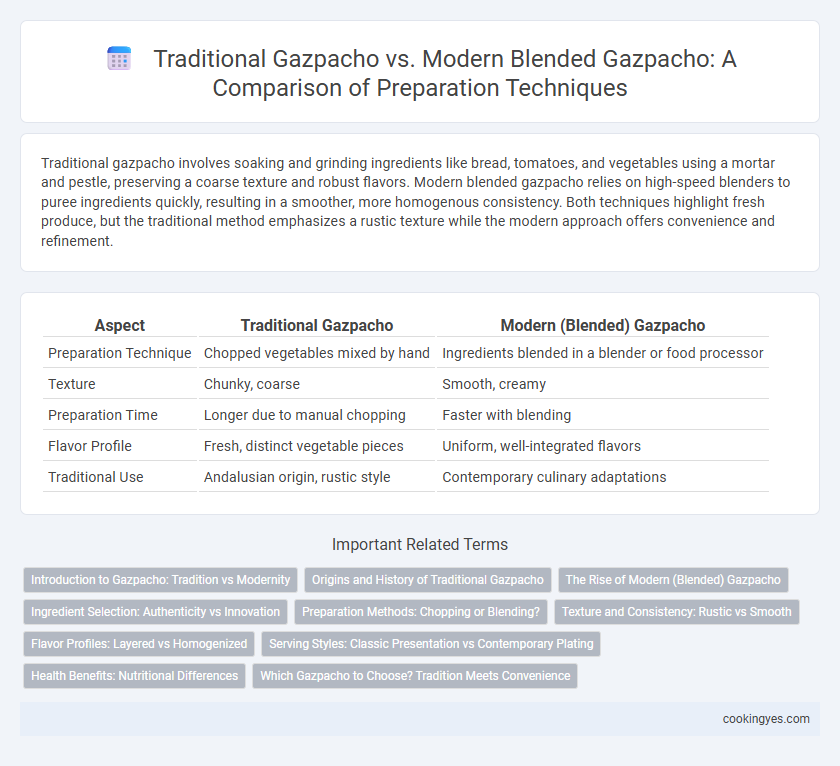Traditional gazpacho involves soaking and grinding ingredients like bread, tomatoes, and vegetables using a mortar and pestle, preserving a coarse texture and robust flavors. Modern blended gazpacho relies on high-speed blenders to puree ingredients quickly, resulting in a smoother, more homogenous consistency. Both techniques highlight fresh produce, but the traditional method emphasizes a rustic texture while the modern approach offers convenience and refinement.
Table of Comparison
| Aspect | Traditional Gazpacho | Modern (Blended) Gazpacho |
|---|---|---|
| Preparation Technique | Chopped vegetables mixed by hand | Ingredients blended in a blender or food processor |
| Texture | Chunky, coarse | Smooth, creamy |
| Preparation Time | Longer due to manual chopping | Faster with blending |
| Flavor Profile | Fresh, distinct vegetable pieces | Uniform, well-integrated flavors |
| Traditional Use | Andalusian origin, rustic style | Contemporary culinary adaptations |
Introduction to Gazpacho: Tradition vs Modernity
Traditional gazpacho features a preparation technique that involves soaking stale bread with fresh vegetables like tomatoes, cucumbers, and peppers, then manual mashing and blending by hand to achieve a chunky texture. Modern blended gazpacho utilizes high-speed blenders or food processors, creating a smoother, more homogeneous soup with a refined mouthfeel. Both methods highlight the core Mediterranean ingredients but differ significantly in texture and preparation time, reflecting evolving culinary practices while preserving authentic flavors.
Origins and History of Traditional Gazpacho
Traditional gazpacho originates from the Andalusian region of Spain, dating back to Roman times, using coarsely crushed vegetables like tomatoes, cucumbers, and peppers mixed with stale bread, olive oil, vinegar, and garlic in a mortar and pestle or saltcellar. The preparation emphasizes hand-crushing ingredients to preserve texture and authentic flavors without blending. Modern gazpacho techniques evolved with the use of electric blenders to create a smoother consistency, but traditional methods reflect the dish's rustic, regional heritage and historical culinary practices.
The Rise of Modern (Blended) Gazpacho
Traditional gazpacho relies on manually crushed ingredients, preserving a chunkier texture and emphasizing rustic, fresh flavors from soaked bread, ripe tomatoes, cucumbers, and peppers. Modern blended gazpacho employs high-speed blenders to create a smoother, more homogenous soup, enhancing consistency and allowing for creative additions like avocados or herbs. The rise of blended gazpacho reflects contemporary culinary trends favoring convenience, texture refinement, and ingredient innovation, driving its popularity in gourmet and home kitchens alike.
Ingredient Selection: Authenticity vs Innovation
Traditional gazpacho emphasizes using fresh, ripe tomatoes, cucumbers, red peppers, garlic, olive oil, sherry vinegar, and day-old bread to maintain its authenticity and rustic texture. Modern blended gazpacho incorporates innovative ingredients such as avocados, watermelon, or exotic herbs, creating smoother, creamier textures and unique flavor profiles. Ingredient selection in traditional recipes prioritizes regional authenticity, while modern versions focus on culinary experimentation and diverse taste experiences.
Preparation Methods: Chopping or Blending?
Traditional gazpacho relies on finely chopping fresh vegetables like tomatoes, cucumbers, and peppers to create a textured, rustic consistency emphasizing the natural crunch and bite of the ingredients. Modern blended gazpacho uses high-powered blenders or food processors to puree the ingredients into a smooth, creamy soup, enhancing flavor integration and achieving a uniform texture. Both methods highlight distinct sensory experiences, with chopping preserving more individual vegetable character and blending offering a more homogenized, velvety finish.
Texture and Consistency: Rustic vs Smooth
Traditional gazpacho features a rustic texture with coarsely chopped vegetables, creating a chunkier consistency that highlights individual ingredients. Modern blended gazpacho emphasizes a smooth, velvety texture achieved through thorough blending or pureeing, resulting in a uniform and creamy consistency. Preference between the two often depends on desired mouthfeel, with rustic gazpacho offering a heartier bite and modern styles providing a more refined, fluid experience.
Flavor Profiles: Layered vs Homogenized
Traditional gazpacho preparation relies on finely chopped vegetables, creating a textured, layered flavor profile where each ingredient distinguishes itself. Modern blended gazpacho employs powerful blenders that homogenize the ingredients into a smooth, unified mixture, emphasizing a consistent, evenly distributed taste. This method enhances the harmony of flavors but reduces the distinctiveness found in the traditional, rustic variant.
Serving Styles: Classic Presentation vs Contemporary Plating
Traditional gazpacho is served in simple bowls or glasses, emphasizing its rustic, chilled soup qualities with garnishes like diced vegetables or a drizzle of olive oil. Modern blended gazpacho often features refined plating styles, using smooth textures and artistic presentations such as layering or foams to highlight its elegance. These contemporary serving techniques transform gazpacho from a humble dish into a sophisticated appetizer or amuse-bouche.
Health Benefits: Nutritional Differences
Traditional gazpacho relies on raw, chopped vegetables such as tomatoes, cucumbers, and peppers, preserving fiber content and promoting digestive health. Modern blended gazpacho, though smooth and creamy, may reduce fiber but enhances nutrient bioavailability, increasing absorption of antioxidants like lycopene and vitamin C. Both versions provide low-calorie, hydrating benefits rich in vitamins A and E, but traditional recipes emphasize whole-food texture while modern blends optimize nutrient delivery.
Which Gazpacho to Choose? Tradition Meets Convenience
Traditional gazpacho relies on manual chopping and soaking of fresh vegetables, preserving textures and authentic flavors, ideal for those valuing culinary heritage. Modern blended gazpacho employs high-speed blenders for smooth consistency and faster preparation, perfect for convenience without sacrificing the core ingredients like tomatoes, cucumbers, and peppers. Choosing between them depends on preference for texture and preparation time, balancing tradition's rich mouthfeel against modern efficiency.
Traditional gazpacho vs Modern (blended) gazpacho for preparation technique Infographic

 cookingyes.com
cookingyes.com